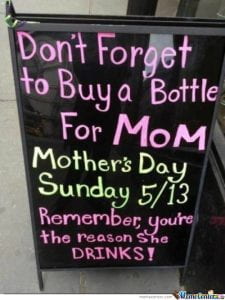What is it?
“Mommy’s juice” refers to a beer or liquor for a mom who is tired of dealing with her screaming kids. There have been memes, jokes between friends, movies, and ads dedicated to women and their love for alcohol. Sometimes it can feel like there’s no escaping the “mommy juice” joke. I personally came across a meme with a picture of a woman drinking wine captioned “Never give up on something you can not go a day without thinking about”. They are considered “Funny” but they have a considerable impact on alcohol and its use. Another example is the commercial advertisement reported by the New York Times in the spring of 2019, a liquor company that produces a Mad housewife wine offered a Mother’s Day promotion: a six-pack of wine called Mommy’s Little Helper.
picture by google
The biggest switch
The biggest recent change in alcohol commercial advertisement and memes is that its target has been women. With the aim of normalizing very high-risk alcohol drinking through the internet. Liquor companies and internet users share memes and advertisements that sadly become viral and embed messages.
picture by google
Taking more than 1 drink a day is a high risk for women and cause a lot of health problems attributable to alcohol. Women metabolize alcohol differently from men. Therefore, women are more likely to become drunk quickly than men and health problems often progress more quickly in women than in men.
Potential consequences.
These memes and commercial products related to alcohol drinking have contributed to a startling increase in the number of women who drink in the US. The increased alcohol consumption pattern in women is no laughing matter.
Another noticeable effect of “mommy juice” is the increase of Alcohol-related deaths among women in the United States (Institute for Health Metrics and Evaluation (IHME) 2017). The study found that from the year 2007 to 2017, the number of alcohol-related deaths in the U.S. increased by 85% among women while deaths attributable to alcohol among men rose by 35%. That’s about 50% difference!
A study by Agbio, R et al (2017) found that women are more likely to turn to alcohol for a negative reinforcement effect like to decrease feeling bad, and temporary melt away some anxiety and stress, while men tend to use alcohol for its positive reinforcement — they drink to party, “get wasted,” and have fun. The alcohol companies use this weakness to push their product by convincing women that their products can fix their problems.
Lastly, women need to be aware that the alcohol industry is targeting them deliberately and they aim at encouraging high-risk drinking by using themes like “Mommy juice”, “mommy burnout”, “mommy needs her wine” in order to sell these products. A call for action by local and federal authorities to combat this problem before it’s too late is needed. I think this is not given much attention by the media and public health as it should. Just like the tobacco industry, I would like to suggest that serious action be taken against the advertising strategies.
Sources:
- Agabio, R., Pisanu, C., Gessa, G. L., & Franconi, F. (2017). Sex Differences in Alcohol Use Disorder. Current Medicinal Chemistry, 24(24). doi:10.2174/0929867323666161202092908
- Institute for Health Metrics and Evaluation (IHME) 2017, Alcohol-related deaths Retrieved from http://www.healthdata.org/policy-report/findings-global-burden-disease-study-2017



